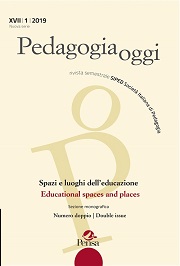School as a sacred space. On the theocratic heritage in the New Education movement
Abstract
The discourse about “space” or “spaces” in the context of history is often associated with a martial intention. Following its discovery, geographical space beyond the previously known became an object of desire and conquer. A means of “peaceful” disciplining by the European conquerors was the Christian mission. Education was – and in some parts still is – in curricular as well as in spatial respects organized as an appendix of the (Christian) church. The hierarchical structure connected with it, with a normative transcendence space “above” and an earthly “below”, which was urged to be submissive, was then also adopted by the secular school. The theocratic heritage of pedagogy has thus been more or less visibly passed on, even though the unconditional norm-giving has undergone a change in content, in the State school that represent the transcendental normative of religion under a new guise. With regard to influential school concepts of the New
Education Movement, it can be shown how the pedagogical explicitly re-transforms itself into the religious – in the sense of a sacred space in which the salvation of the individual and the community, even of mankind as a whole, is worked on. Individual concepts define it differently, but they all are united by the conviction that the educational space must and can already be a model for the better world of the future, where the child still learns for life, but now within the milieu of the New World. In it, the child follows his/her teleological intrapsychically-inscribed trace of development (Montessori), the trace of the cosmic universally-acting Spirit (Steiner) or the trace of the dialectic historically inscribed law for the higher development of society and of the
individual who is finally rescued from the bondage of capital (Blonsky).




